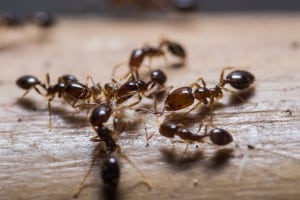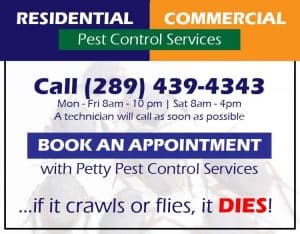This is an excellent article on Ant Extermination and Ant Control by Barb Ogg, PhD, Extension Educator http://lancaster.unl.edu/pest/resources/antcontrol003.shtml
And while Dr. Ogg refers to Nebraska, the content applies equally well here in Ontario.
“How can I get rid of ants in my house?” . . . . .is one of the most common homeowner complaints heard by professional pest control specialists. Ants invade the home to forage for food, seek shelter, or both. This article, provided by a pest extermination services company, explains ant behavior and provides control tips so you, the homeowner, are better equipped to deal with this pest.
Behavior
All ants live in colonies, consisting of an egg-laying female (queen), short-lived males, and workers (sterile females). The ants you see foraging in your garden or kitchen are workers. Workers that find food communicate with other workers by depositing a chemical message on the substrate as they crawl back to the colony. Although we cannot smell it, this “trail pheromone” sticks to the substrate for long periods of time and helps other ants find the food at the end of the trail.
In the spring, ants develop wings fly to new locations, and invade homes to forage for food or to establish a new colony.
Termites also develop wings and swarm during the spring and look similar to flying ants. Examine them closely to make sure that you have the correct pest! Ants are thin-waisted and have elbowed antennae. Termites have thicker waists and antennae that resemble strings of tiny beads. You may need a magnifying glass to examine antennal features.
As a group, ants have a wide food range, feeding on sweet foods, greasy materials, starchy substances, wood, and all kinds of plant and animal materials. Part of the reason that these insects become a nuisance in our homes is that they often like the same kinds of food that we do.
Ant Control
Two categories of ants will be encountered when experiencing a pest problem with these insects. The control strategy that you should take depends on your type of infestation.
Ants that live outside and forage in the home
Those that live outside will travel inside the home to search for food. Some species may ultimately reside in houses, as discussed later in this fact sheet. To prevent both of these scenarios, follow these procedures:
- First, cracks and crevices should be sealed to eliminate passages into the home. If you do not seal entry points, ants will probably find their way into your house at some later time.
- Second, scrub around entry points with a detergent (to remove the trail pheromone) and spray a residual pesticide around entry points.
Bait treatments and pesticides are reliable pest exterminators that can be used to control ants in their mounds. To be effective baits must be placed in areas where ants frequent, eaten, and be taken back to the formicary. There are several different kinds of bait available, and you may have to do a little trial-and-error to find the proper bait. Because they must get back to the colony for satisfactory control this strategy may be incompatible with insecticide sprays which may kill worker ants before they can get back to the formicary with the bait. The successful use of bait may take several weeks or more.
Insecticide dilutions can be used outside to successfully drench colonies. Be sure to follow label recommendations for correct procedures when applying the insecticide. But if your durable ant problem persists, contact us, and we’ll send our ant exterminators to give you back your peace of mind and make your home ant-free.
Ants that live (nest) inside your home
Yes, some types of ants establish a formicary inside your home instead of merely entering to forage for food and returning outdoors. Ants in this category may be present year-round, although they will be more active in the warmer months. Species of ants that live in Nebraskan homes include crazy ants, odorous house ants, pavement ants, pharaoh ants, thief ants, and carpenter ants.
But for ant species found in Ontario, one should watch out for the invasive European fire ant. These territorial and aggressive fire ants are easily disturbed and people who were bit describe the sensation as feeling as if a wasp stung them. Any infestation by any of the above ants and other pests necessitates getting in touch with your local pest control and removal services.
All of them may infest food products. Spraying a residual insecticide to control foraging workers may provide only short-term control. Even when over 99 percent of foraging workers are killed by insecticide sprays, the colony may rebuild to its original numbers. Location and destruction of the colony is the most direct way to eliminate this infestation.
Ant baits, described above, can again be a useful tool in exterminating inside-the-home ant colonies, although baits may not work as well with carpenter ants as the other species mentioned. Again, workers must eat the bait, take it back to their colony, and feed to the queen and larval ants. This type of control is incompatible with treatments that prevent workers from returning to the colony with the bait.
Unlike other home-inhabiting ants, carpenter ants use their mandible to damage wooden structures to construct tunnels and inhabit wood infrastructure. However, they rarely settle in sound wood, but consistently invade wood that has become wet and started to decay. Carpenter ants are large (about 3/8 to 1/2″ long) and black or red.
The best way to control carpenter ants that inhabit a dwelling is to find the nest and destroy it. Insecticide sprays inside the home will kill some of the worker ants, but unless the entire formicary is neutralized, the queen will continue to produce additional members for the colony. Locating a nest can be difficult because colonies may be in locations within the walls or roof rafters. At this point, some homeowners may prefer to work with a pest control company and their professional ant control experts. The most likely places to find nests are where wood has been wet and weathered, such as rotting timbers about the foundation, window sills, porches, around leaky plumbing, and in rafters under a leaky roof.
Ants are generally most active in the evening hours foraging for all kinds of food, both inside the house and outside. By following them, you may be able to tell where the formicary is. Because carpenter ants keep the tunneled galleries very clean and push the sawdust and dead insect parts out of small holes in the wood, a small, fresh pile of sawdust under the nest timber is the usual sign of an active carpenter ant colony. Once a colony is found, the extermination process starts entailing the use of either insecticide dust or spray. Injection of insecticide into wall voids or the colony itself may be necessary to ensure complete control.
To prevent further infestations, trim all trees and bushes so branches do not touch the house and correct moisture problems such as leaky roofs and plumbing. Paint and/or seal exposed wood construction before it becomes wet. Replace previously ant-infested wood, rotted, or water-damaged wooden parts of the structure and eliminate wood/soil contacts. Remove dead stumps on the property and store firewood off the ground and away from the structure.
Ants are a major annoyance to homeowners and are difficult to control. You should not underestimate the importance of good sanitation to eliminate food sources, although good sanitation may not control an infestation by itself.
Although we do not like sharing our homes with these insects, they are beneficial organisms in the balance of nature. In nature, they greatly reduce the amount of dead and decaying plant and animal organic matter. They also aerate the soil with their mounds. Since ant species have a fondness for honeydew that aphids produce from feeding on plants, large numbers of ants crawling on a plant may be a sign of serious aphid infestation.
Summary
Ant infestations are not easy to control and different strategies should be used depending on the colony’s location and food preferences. They can be controlled with a combination of good sanitation, removing pheromone trails, caulking entry points, and eliminating active colonies. Insecticide sprays and baits can be used to kill foraging ants and destroy colonies, but strategies designed to prevent further infestations should be used in conjunction with chemical treatment.
Petty Pest Control Services provides both residential and commercial properties with ant extermination and ant control services in Kitchener-Waterloo, and Cambridge in Ontario. If you are facing an ant infestation, call us today, and our pest control team and their exterminators will quickly and professionally get rid of the ants inside your property, home, or business.
Besides Kitchener Waterloo, we also service; the Greater Toronto and Hamilton Area, Guelph, and the Niagra Region. We also provide immediate emergency services anytime 24-7.


